What does work’ look like for you and your team in this current situation?
If your team is working remotely or combining work in the office with work from home, there may be a lack of certainty about when we may all be able to return to work as we knew it, and when we do, what will it be like? Even over conferencing platforms like Zoom, Teams or WebEx, chances are the face-to-face natural social interactions you’d share in the workplace have dramatically diminished over the past year.
As a leader, you also worry about looking after your peoples’ wellbeing, output and results while dealing with your own situation. We all have different levels of resilience, different needs for social interaction, different needs for the amount of feedback and interaction with our leaders.
The effect can be, to say the least, psychologically stressful on everyone.
Yet work needs to go on. How do you do this?
Firstly as a leader, identify what your needs are at this time.
How does being naturally introverted or extroverted impact you in this situation and under what conditions do you do your best work? Are you missing the hum of the office or are you happy working squirrelled away from your remote location?
These factors will likely influence your leadership response and accessibility at this time.
What we do know, however, is that under our obligations under the WHS/OHS Acts, Regulations and Codes of Practice such as Communication and Consultation and Risk Management – leaders in organisations need to demonstrate Duty of Care.
Here are 7 tips for keeping your people safe and engaged while working remotely
1.Ensure your people are safe wherever they are working
Employers’ duties extend to workers who work from home or remotely, and must take steps to ensure, so far as is reasonably practicable, the health and safety of their workers. Comcare has developed a Working From Home Checklist for employers and workers with guidance and measures on how they can meet their respective work health and safety obligations.
Download the Working From Home Checklist here >>.

2. Give people space
Acknowledge that work is different in many aspects when working remotely. This is the time to assess people on their output, not the clock, and short of installing surveillance cameras in everyone’s home, leaders have to trust people. A study from the Society for Human Resource Management found 77% of workers reported greater productivity while working offsite; 30% said they accomplished more in less time and 24 % said they accomplished more in the same amount of time.
Encourage your people to use outdoor spaces where possible when they take breaks from their computer and try to incorporate some exercise or other activity as part of their working day.
Trust people to do the right things, even though their days might be a mash-up of stop-start-stop-start-stop-stop-start, most people are bending over backwards to do a great job from home.
3.Create community – The Virtual Water Cooler
Create an open room in an online meeting tool like Zoom, WebEX, Skype or Microsoft Teams, and give your team the meeting code so they can join from wherever they are.
Set a time in the workday that works for everyone, say a morning coffee break, afternoon tea or end of the week wine time (or whine time) where people drop into the online meeting and can see each other and talk about non-work related things. Being able to see one another makes a difference. This is not a work meeting, it’s an essential mental health break.
4. Communicate and tell it straight
Create a weekly News from the Trenches via email, video or Facebook live (to a private group of your people, if it’s appropriate for your workplace) — that outlines how the organisation is going – any initiatives, new clients/opportunities – feedback from clients and customers – how many sales made etc. Be straight, but positive where you can. Anything that reinforces that the business is making headway. A lot of people are terrified about losing their jobs or businesses closing down for good. If you can, reassure them of the steps the business is taking, what government assistance your business is utilising to keep them employed and the business operating, as well as future plans. Knowing is better than the fear of the unknown.
5. Reach out personally
As a leader, call your people regularly and ask How are you going?, What can I/the business do to support you?, “Do you have the resources to do your job remotely?” and check-in on their wellbeing. Keep them up to date with anything impacting their specific role or responsibilities and ask for ways that you can collaborate to further improve the remote working scenario.
If someone is struggling who is usually a great performer, reach out and ask them how they’re doing and seek to understand where they are at – is it a resourcing issue? The business landscape? Are the complexities of their specific role challenging to do remotely? Is it stress from the dynamics at home? Complete exhaustion? The key is to also listen and acknowledge rather than just talking.
6. Acknowledge people
Most team members thrive on positive feedback, acknowledge them for what they’ve done well either publically or personally and let them know their hard work under the current working conditions hasn’t gone unnoticed.
7. Turn fears into ideas – innovate
While some industries and business are being disrupted and decimated by the pandemic response, others are innovating their way to survival. Ask your team if they see any opportunities to innovate – has the current situation created any opportunities to offer new products, in new ways into new channels or to innovate with processes? Ask if people have any suggestions or can see any new opportunities – how can you turn fears into ideas? Your people are some of the best resources you’ll have for coming up with business innovation and this may be a new opportunity to thrive, both as a business and as an engaged remote team.
Research source: Society for Human Resource Management
https://www.shrm.org/resourcesandtools/hr-topics/technology/pages/teleworkers-more-productive-even-when-sick.aspx

